Revised Nov 19, 2014
with a new illustration updating the pectoral girdle and a nesting closer to Qianxisaurus.
A paper published today in Nature (Motani et al. 2014b) introduces us to Cartorhynchus lenticarpus (Fig. 1a, b), a distinctively different sort of reptile with flippers, which the authors nested with ichthyosaurs. They said it filled an evolutionary gap.
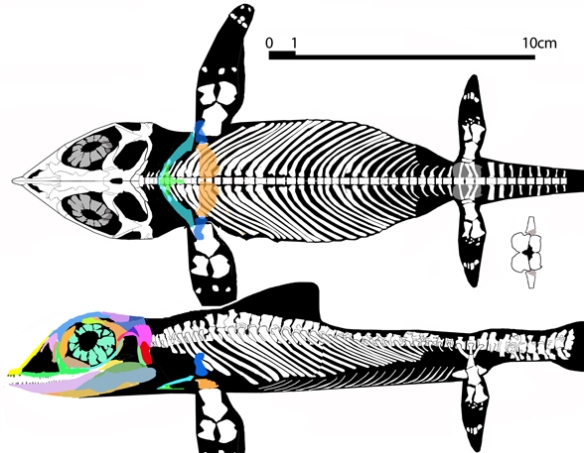
Figure 2. Cartorhynchus reconstruction in lateral and dorsal views with new lateral view skull and pectoral girdle.
That hypothesis was tested and falsified.
Cartorhynchus is actually the first representative of a whole new clade of ichthyosaur-like pachypleurosaurs. A new clade is always great news.
Here, in the large reptile tree (Fig. 2), Cartorhynchus nests as a basal pachypleurosaur (when more cartorhynchids are found, then we’ll talk about a new clade). Currently Pachypleurosaurus and Qianxisaurus are sister taxa. Cartorhynchus is distinguished by its more fish-like shape with a large head, short rostrum, short neck, large anterior flippers, small posterior flippers and posteriorly tapering torso and tail.
Essentially it was an ichthyosaur mimic.
Shifting Cartorhynchus to the ichthyosaurs adds 35 steps.
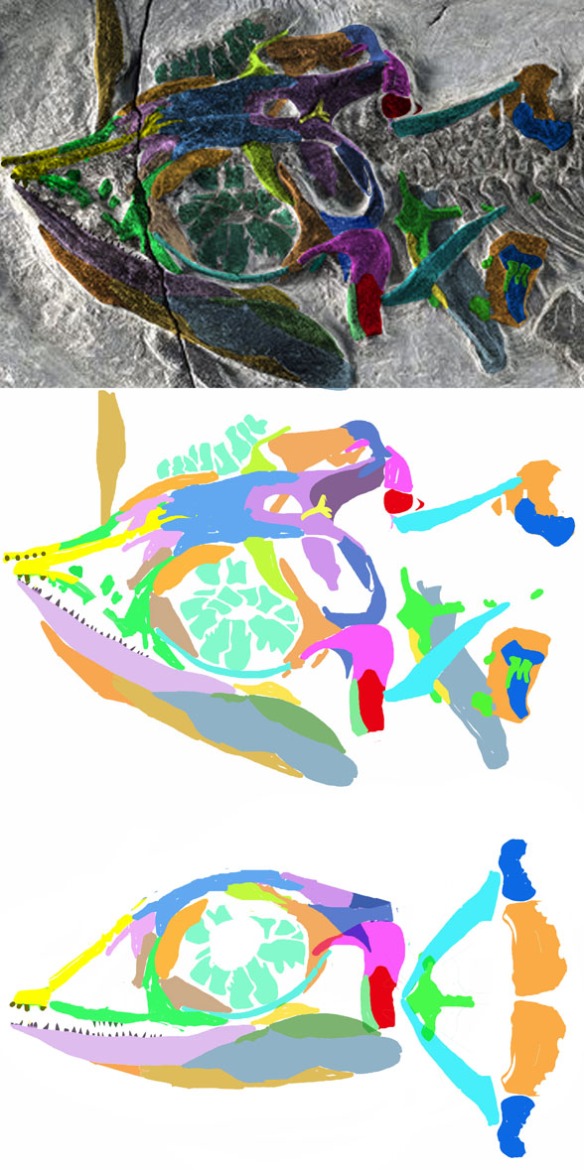
Figure 1. New tracing and reconstruction of the basal sauropterygian with flippers, Cartorhynchus.
From the Motani et al. abstract: “The incompleteness of the fossil record obscures the origin of many of the more derived clades of vertebrates. One such group is the Ichthyopterygia, a clade of obligatory marine reptiles that appeared in the Early Triassic epoch, without any known intermediates. (1) Here we describe a basal ichthyosauriform from the upper Lower Triassic (about 248 million years ago) of China, whose primitive skeleton indicates possible amphibious habits. It is smaller than ichthyopterygians and had unusually large flippers that probably allowed limited terrestrial locomotion. It also retained characteristics of terrestrial diapsid reptiles, including a short snout and body trunk (2). Unlike more-derived ichthyosauriforms, it was probably a suction feeder. The new species supports the sister-group relationships between ichthyosauriforms and Hupehsuchia, the two forming the Ichthyosauromorpha. Basal ichthyosauromorphs are known exclusively from south China, suggesting that the clade originated in the region, which formed a warm and humid7 tropical archipelago in the Early Triassic. The oldest unequivocal record of a sauropterygian [Majiashanosaurus] is also from the same stratigraphic unit of the region.” (3). Notes answered below.
(1) So, Montani et al, do not know about or prefer not to reference www.reptileevolution.com, which has nested ichthyosaurs and kin with thalattosaurs and mesosaurs for the last three years. None of these taxa have a short rostrum or short torso.
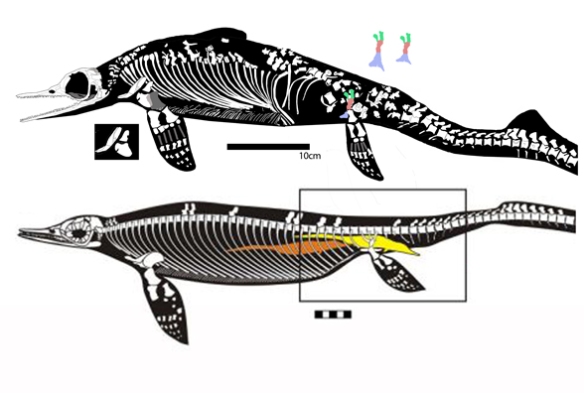
Figure 2. Chaohusaurus nested as a sister to Cartorhynchus in the Motani et al. tree, and they do indeed resemble one another. The posterior half is hypothetical. Adding Cartorhynchus to the ichthyosaurs adds 35 steps. Above, traced from specimen AGM CHS-5. Below, stylized with embryos from Motani et al. 2014a
(2) Traits also shared with Claudiosaurus, Anarosaurus and Sinosaurosphargis, taxa related to Cartorhynchus after Pachypleurosaurus and Qianxisaurus.
(3) It should be no surprise that two taxa found in close proximity are related to one another. Majiashanosaurus is only two nodes away from Cartorhynchus (Fig. 5). This stratum was the birthplace for the sauropterygia.
The Motani et al. (2014, Fig. 3) tree is riddled with problems.
Using suprageneric taxa is the big problem. Using too few taxa is the other big problem.
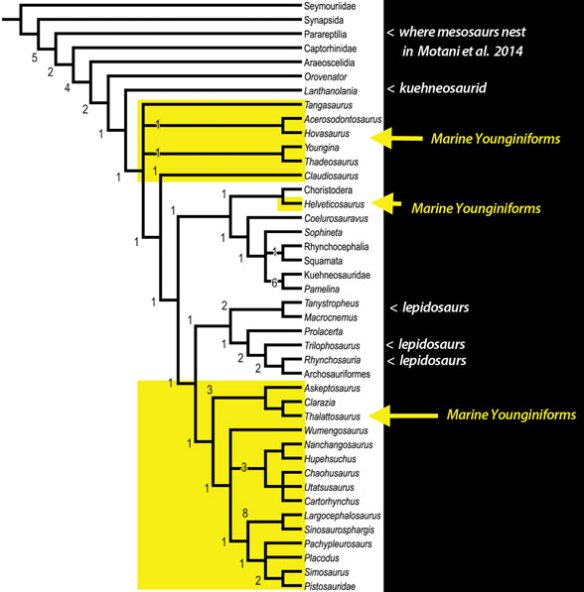
Figure 3. The Motani et al. tree with corrections in black. Nice to see Wumengosaurus at the base of the Ichthyosauria. The mesosaurs are absent, tucked away in ‘parareptilia.’ Palatodonta, Anarosaurus, and Majiashanoosaurus are also absent. You need to include the real sisters if you want an accurate tree.
The large reptile tree is a ready resource that should be used more often.
Here (Fig. 4) is where Cartorhynchus nests in a subset of the large reptile tree. While pachypleurosaurs all have a small skull and long neck, related placodonts have a large head and short skull. Both clades produced taxa with flippers. The new clade of cartorhynchids will, no doubt, someday produce basal taxa with fingers and toes.
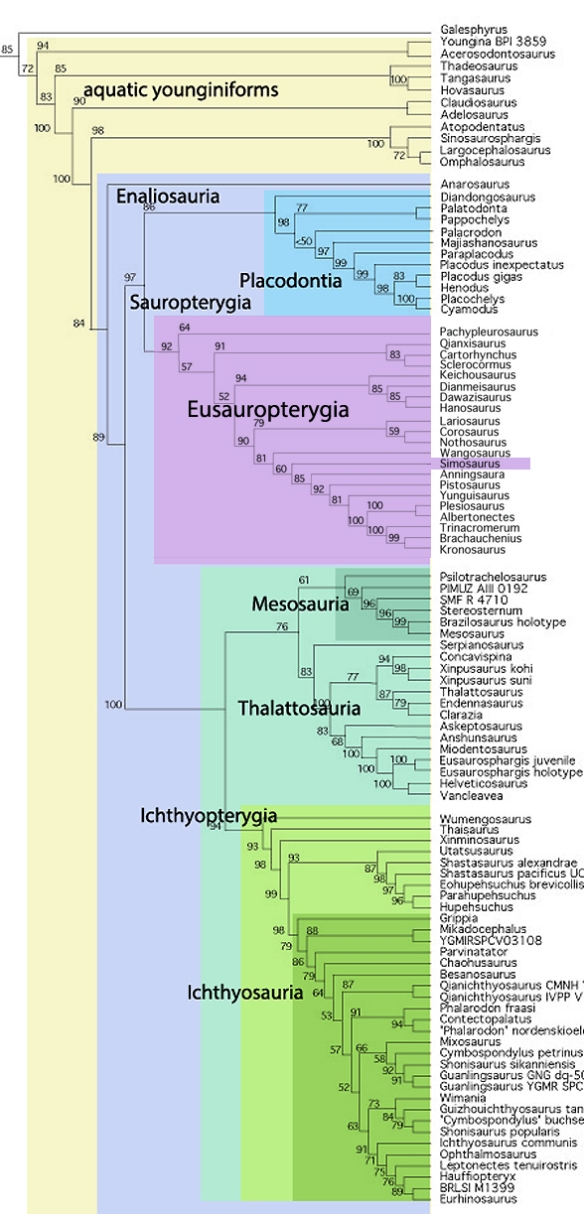
Figure 3. Aquatic younginiform subset of the LRT demonstrating relationships within the Enaliosauria (=Sauropterygia + Ichthyosauria)
To their credit,
Motani et al. follow in the steps of reptile evolution.com as they nest Wumengosaurus basal to ichthyosaurs. It was originally considered a pachypleurosaurid, and it is one, just a very derived one, basal to other clades. Does nobody else recognize the similarity of Wumengosaurus to mesosaurs?? You’ll notice in the above tree that other former pachypleurosaurs are also basal to various marine clades.
Let’s pretend mesosaurs never existed.
When mesosaurs are removed, the large reptile tree topology does not change. But that nests Sauropterygia as the sister to icthyosauriforms + thalattosauriforms with Cartorhynchus at the base of the Sauropterygia. That combined clade is known as the Enaliosauria (Owen 1839).
Let’s also remove taxa not used by Motani et al.
When you remove other the basal sauropterygians, Palatodonta, Majiashunosaurus, Atopodentatus, Anarosaurus, Pachypleurosaurus and Qianxisaurus, the tree topology still does not change. Cartorhynchus is firmly nested at the base of the Sauropterygia, not the ichthyosauriforms.
Probably a juvenile
Cartorhynchus is probably a juvenile based on its small size, large orbit, short rostrum and poorly ossified phalanges. I see Cartorhynchus as less of an amphibious taxon than its sister taxa. It did have flippers while its true sisters still had legs.
Probably not a suction feeder either.
Suction feeders, like right whales and sea horses generally have a tube-like snout. That doesn’t seem to be the case with Cartorhynchus. I found many teeth in the jaws. The palate was of a basic pachypleurosaur morphology.
So, like Atopodentatus, Cartorhynchus could be viewed as a completely different sort of marine reptile, but both can be nested at or near the base of the Sauropterygia, where experimentation in the new wet medium went wild.
References
Motani R et al. 2014b. A basal ichthyosauriform with a short snout from the Lower Triassic of China. Nature doi:10.1038/nature13866
Motani R, Jiang D-Y, Tintori A, Rieppel O, Chen G-B 2014a. Terrestrial Origin of Viviparity in Mesozoic Marine Reptiles Indicated by Early Triassic Embryonic Fossils. PLoS ONE Online here.
